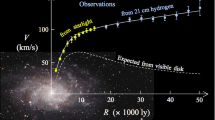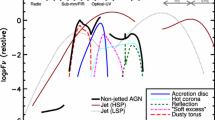Abstract
The surface brightness fluctuations (SBF) method measures the variance in a galaxy’s light distribution arising from fluctuations in the numbers and luminosities of individual stars per resolution element. Once calibrated for stellar population effects, SBF measurements with HST provide distances to early-type galaxies with unrivaled precision. Optical SBF data from HST for the Virgo and Fornax clusters give the relative distances of these nearby fiducial clusters with 2% precision and constrain their internal structures. Observations in hand will allow us to tie the Coma cluster, the standard of comparison for distant cluster studies, into the same precise relative distance scale. The SBF method can be calibrated in an absolute sense either empirically from Cepheids or theoretically from stellar population models. The agreement between the model and empirical zero points has improved dramatically, providing an independent confirmation of the Cepheid distance scale. SBF is still brighter in the near-IR, and an ongoing program to calibrate the method for the F110W and F160W passbands of the Wide Field Camera 3 IR channel will enable accurate distance derivation whenever a large early-type galaxy or bulge is observed in these passbands at distances reaching well out into the Hubble flow.







Similar content being viewed by others
References
Ajhar, E.A., Tonry, J.L., Blakeslee, J.P., Riess, A.G., Schmidt, B.P.: Astrophys. J. 559, 584 (2001)
Barber DeGraaff, R., Blakeslee, J.P., Meurer, G.R., Putman, M.E.: Astrophys. J. 671, 1624 (2007)
Biscardi, I., Raimondo, G., Cantiello, M., Brocato, E.: Astrophys. J. 678, 168 (2008)
Blakeslee, J.P.: Surface brightness fluctuations as stellar population indicators. In: Probing Stellar Populations out to the Distant Universe. American Institute of Physics Conference Series, vol. 1111, p. 27 (2009)
Blakeslee, J.P., Ajhar, E.A., Tonry, J.L.: Distances from the correlation between galaxy luminosities and rotation rates. In: Post-Hipparcos Cosmic Candles. Astrophysics and Space Science Library, vol. 237, p. 181 (1999)
Blakeslee, J.P., Vazdekis, A., Ajhar, E.A.: Mon. Not. R. Astron. Soc. 320, 193 (2001)
Blakeslee, J.P., Lucey, J.R., Tonry, J.L., et al.: Mon. Not. R. Astron. Soc. 330, 443 (2002)
Blakeslee, J.P., Jordán, A., Mei, S., et al.: Astrophys. J. 694, 556 (2009)
Blakeslee, J.P., Cantiello, M., Mei, S., et al.: Astrophys. J. 724, 657 (2010)
Blakeslee, J.P., Cho, H., Peng, E.W., et al.: Astrophys. J. 746, 88 (2012)
Bruzual, G., Charlot, S.: Mon. Not. R. Astron. Soc. 344, 1000 (2003)
Cantiello, M., Raimondo, G., Brocato, E., Capaccioli, M.: Astron. J. 125, 2783 (2003)
Cantiello, M., Blakeslee, J.P., Raimondo, G., et al.: Astrophys. J. 634, 239 (2005)
Cantiello, M., Blakeslee, J., Raimondo, G., Brocato, E., Capaccioli, M.: Astrophys. J. 668, 130 (2007a)
Cantiello, M., Raimondo, G., Blakeslee, J.P., Brocato, E., Capaccioli, M.: Astrophys. J. 662, 940 (2007b)
Cantiello, M., Brocato, E., Capaccioli, M.: Astron. Astrophys. 534, A35 (2011)
Ciardullo, R., Feldmeier, J.J., Jacoby, G.H., et al.: Astrophys. J. 577, 31 (2002)
Côté, P., Blakeslee, J.P., Ferrarese, L., et al.: Astrophys. J. Suppl. Ser. 153, 223 (2004)
Ferrarese, L., et al.: Astrophys. J. 529, 745 (2000)
Freedman, W.L., Madore, B.F.: Annu. Rev. Astron. Astrophys. 48, 673 (2010)
González-Lópezlira, R.A., Bruzual, G., Charlot, S., Ballesteros-Paredes, J., Loinard, L.: Mon. Not. R. Astron. Soc. 403, 1213 (2010)
Jensen, J.B., Tonry, J.L., Luppino, G.A.: Astrophys. J. 505, 111 (1998)
Jensen, J.B., Tonry, J.L., Barris, B.J., et al.: Astrophys. J. 583, 712 (2003)
Jordán, A., Blakeslee, J.P., Côté, P., et al.: Astrophys. J. Suppl. Ser. 169, 213 (2007)
Lee, H.-C., Worthey, G., Blakeslee, J.P.: Astrophys. J. 710, 421 (2010)
Liu, M.C., Charlot, S., Graham, J.R.: Astrophys. J. 543, 644 (2000)
Marín-Franch, A., Aparicio, A.: Astron. Astrophys. 450, 979 (2006)
Mei, S., Blakeslee, J.P., Tonry, J.L., et al.: Astrophys. J. Suppl. Ser. 156, 113 (2005a)
Mei, S., Blakeslee, J.P., Tonry, J.L., et al.: Astrophys. J. 625, 121 (2005b)
Mei, S., Blakeslee, J.P., Côté, P., et al.: Astrophys. J. 655, 144 (2007)
Mieske, S., Hilker, M., Infante, L.: Astron. Astrophys. 458, 1013 (2006)
Mould, J., Sakai, S.: Astrophys. J. 694, 1331 (2009)
Raimondo, G.: Astrophys. J. 700, 1247 (2009)
Raimondo, G., Brocato, E., Cantiello, M., Capaccioli, M.: Astron. J. 130, 2625 (2005)
Riess, A.G., Macri, L., Casertano, S., et al.: Astrophys. J. 730, 119 (2011)
Tonry, J.L., Schneider, D.P.: Astron. J. 96, 807 (1988)
Tonry, J.L., Ajhar, E.A., Luppino, G.A.: Astron. J. 100, 1416 (1990)
Tonry, J.L., Blakeslee, J.P., Ajhar, E.A., Dressler, A.: Astrophys. J. 475, 399 (1997)
Tonry, J.L., Blakeslee, J.P., Ajhar, E.A., Dressler, A.: Astrophys. J. 530, 625 (2000)
Tonry, J.L., Dressler, A., Blakeslee, J.P., et al.: Astrophys. J. 546, 681 (2001)
Worthey, G.: Astrophys. J. 409, 530 (1993)
Acknowledgements
I thank the conference organizers for inviting me to talk on this subject. I am indebted to my sundry SBF collaborators, including my colleagues from the ACS Virgo and Fornax cluster surveys, for their many contributions to this work.
Author information
Authors and Affiliations
Corresponding author
Rights and permissions
About this article
Cite this article
Blakeslee, J.P. Surface brightness fluctuations as primary and secondary distance indicators. Astrophys Space Sci 341, 179–186 (2012). https://doi.org/10.1007/s10509-012-0997-6
Received:
Accepted:
Published:
Issue Date:
DOI: https://doi.org/10.1007/s10509-012-0997-6




